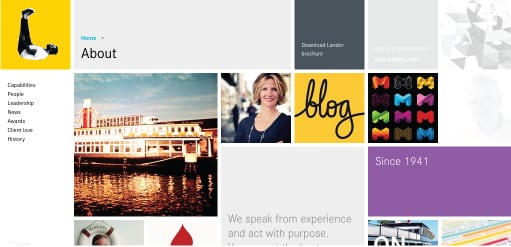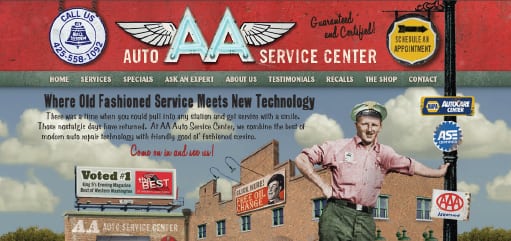Choices. Today the public has a nearly infinite amount of choices on where to find the information they need. Long gone is a trip to the library for research. Everything you need now is online. Wikipedia, Pinterest, Facebook—even Twitter will give you a basic, short description of the person or organization you’re interested in. But no digital platform has more staying power than the trusty Web site. According to eMarketer, 88.1% of U.S. Internet users ages 14+ will browse or research products online in 2012. The majority of them will go to individual sites to find information about people, products and jobs.
While a site’s homepage gets all the attention as the first touch point with visitors, the often overlooked “About” page can also be a powerful tool for delivering brand messaging. But the About page is more than just basic facts: It’s a page that establishes an organization’s credibility, says Aaron Muller, director of business development specialist at Seattle-based online marketing company VisualScope.
“That’s the first thing people look for in an About page,” says Muller. “The page helps answer the question, ‘Do I want to interact with this organization?’”
 |
| The mosaic design of Landor Associate’s About page reflects the innovative and creative work done by the branding agency. |
Just what does an About page represent? It’s really who and what an organization is. Trevor Wade, director of digital marketing at branding agency Landor Associates, says their page is geared towards its audience of clients and prospective clients, employment seekers and Landor employees. “We want to satisfy everyone’s needs and wants with our About page,” says Wade.
BASIC NECESSITIES
“Needs” as in basic information that most people look for in an organization: A short description of what it does and the services it offers; company history; and links to staff, Frequently Asked Questions and Careers.
“Wants” can be trickier. Visitors to an About page want to know more about you, but even more important, they are looking to find out if they want to do business with you. Thus, the About page should convey capabilities while exhibiting a personality, says Wade. Since Landor Associates is a branding agency that focuses on innovation and creativity, its About page reflects that. Designed as a mosaic (see the image), individual tiles link to a variety of sections and content—like People, Blog, Case Studies, Press Releases and In the Media. There’s a lot happening on this page, and Wade says that’s for a reason. “We have a lot going on in our agency, and our About page says so,” she says. “That’s the philosophy of the entire site.”
 |
| This page for AA Auto Service Center communicates a fun brand personality mixed with the basic information needed by customers. |
And much of what is displayed on Landor’s About page is in image form. It’s fitting, since branding is largely visual. More imagery on Web sites is a definite trend, says Muller. Powered by the runaway success of YouTube and more recently Pinterest, telling a story through images—still or video—is a popular strategy, says Muller.
Still, there should be a balance of written word and images. “While we believe a lot in the power of imagery, copy also shows who we are,” says Wade. “They complement each other.”
‘ABOUT’ RECRUITMENT
And good execution of the “who we are” on an About page can go a long way in the employee recruitment process. But there’s a strategy here that goes beyond just linking to a Careers page, says David Kippen founder and head of Evviva Brands, which focuses on integrating organizational messaging around brands.
Kippen says he’s found that different classes and categories of workers search differently for jobs. He cites a large oil and gas company client, which had very high traffic on its site from job seekers. Many were engineers. “These folks were interested in two things first: Leadership and strategy of the company, and their job autonomy,” says Kippen. These are things that could be found or deduced from an About page.
Contrast this with a large hospitality company that attracted hourly workers. “The first thing they wanted to find out is if there was a job opening,” says Kippen. Then, and only then, would they want to learn more about the company.
“The About page is the last place they would look as they undergo the search process,” he says. Kippen says more organizations need to take these differences into account.
THE EMPLOYER BRAND
Central to an About page recruitment strategy is the concept of “employer branding.” Just like there might be a master brand at a company, the employer brand focuses on one message: “If you’re a person who wants to do our kind of work, come to us for an environment that will suit you,” says Kippen.
Employer branding is about conveying same message, same voice, inside and out, continues Kippen. “All the way through being hired, onboarding and through open enrollment—every interaction—there’s a consistency of message and idea that says ‘this is us,’” he says. And that includes what’s on the Web site and the About page.
And employer branding via the Web hits internally too, as the current workforce can get the same messaging via an organization’s external-facing site, rather than through a clunky intranet system.
Here are some tips from Wade on considerations when recharging your About page:
• Think carefully about the type of company you are: “We’re a B2B and we’re selling ourselves and our services,” says Wade.
• People want basic, functional information: They need to know where you’re located, the services you offer, your leadership, while getting a sense of company culture.
• Change up your content: Knowing that there are repeat visitors to page, Landor’s site is built to easily swap content.
• Allow for deeper dives: Visitors to the Landor site can click to testimonials (Client Love section), client work and staff bios.
For you ex-journalists and current PR pros out there, try to remember the five W’s when optimizing your About page. Then, add a P for Personality and an F for a little Feeling. PRN
CONTACT:
Aaron Muller, [email protected]; Trevor Wade, [email protected]; David Kippen, [email protected].
Follow Scott Van Camp: @svancamp01
